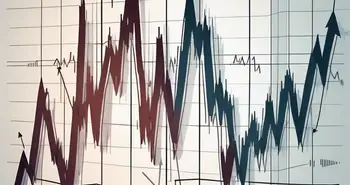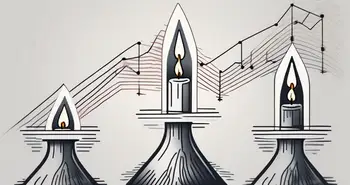Spotting Market Reversals: How to Identify Trend Reversal Patterns
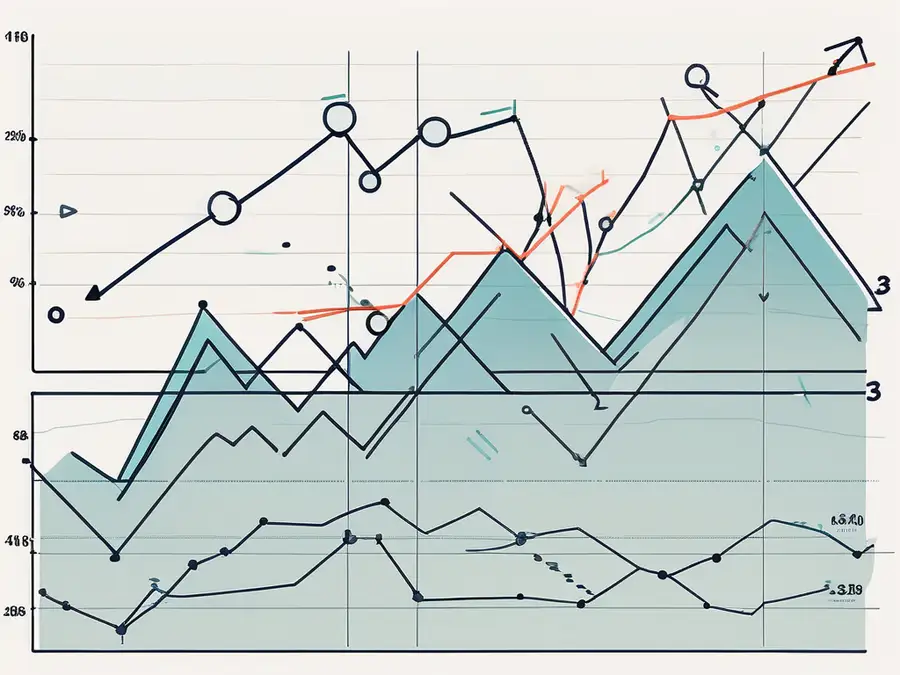
Imagine being able to predict market shifts before they happen, positioning yourself ahead of the crowd, and capitalizing on changes that others only notice in hindsight. For years, I've immersed myself in the intricate dance of the markets, scrutinizing trends and decoding patterns. Through this journey, I've uncovered the immense potential hidden within trend reversal patterns.
These patterns are not just abstract concepts but powerful tools that can turn market volatility into profitable opportunities. Whether you're a seasoned trader or just starting out, understanding and mastering these patterns can transform your trading strategy. In this comprehensive guide, I will reveal the secrets of spotting market reversals, sharing the insights and techniques I've honed over the years. Get ready to enhance your trading skills and unlock new levels of success in the market.
What are Trend Reversal Patterns?
Trend reversal patterns are specific formations or movements in price charts that signal a potential change in the current market trend. These patterns indicate that the ongoing trend, whether it's an upward (bullish) or downward (bearish) movement, may be about to reverse direction.
How They Impact Trading Decisions
The ability to identify and interpret trend reversal patterns can significantly impact trading strategies and outcomes. Here's how:
Entry and Exit Points: Knowing when a trend is likely to reverse helps traders decide the best points to enter or exit trades. For example, spotting a head and shoulders pattern at the peak of an uptrend signals a potential downtrend, suggesting it's time to sell.
Trend Confirmation: Reversal patterns often confirm the end of a trend, providing a signal that the current market sentiment is changing. This confirmation can validate other technical analysis tools and indicators, giving traders more confidence in their decisions.
Strategic Adjustments: Identifying a trend reversal allows traders to adjust their strategies proactively. For instance, shifting from a long position to a short position (or vice versa) can align their trades with the new market direction.
Avoiding False Signals: Trend reversal patterns can help filter out false signals from other indicators. By focusing on well-defined patterns, traders can avoid reacting to temporary market noise and focus on significant trend changes.
Psychological Edge: Being aware of trend reversals can provide a psychological advantage. Traders who anticipate reversals and act accordingly are less likely to be caught off guard by sudden market moves, reducing stress and improving trading discipline.
In summary, trend reversal patterns are not just technical signals; they are strategic tools that can elevate your trading game. By mastering these patterns, you gain a powerful edge: the ability to foresee market movements, make smarter decisions, optimize your profit potential, and manage risks with precision. This transforms your trading approach from mere speculation to a calculated, informed strategy.
Identifying Trend Reversal Patterns in the Market
When it comes to spotting trend reversals, utilizing key indicators and analytical methods is essential. These tools act as warning signs, guiding you towards potential trend reversals. By closely monitoring price action, volume, and momentum, you can gain insights into market sentiment and identify potential turning points.
Key Methods and Indicators for Spotting Trend Reversals
Moving Average Convergence Divergence (MACD)
Overview: The MACD is a momentum indicator that illustrates the relationship between two moving averages of an asset's price.
How to Spot Reversals: Look for divergences between the MACD line and the price chart. For example, if the price is making higher highs while the MACD is making lower highs, this bearish divergence suggests a potential downward reversal. Conversely, bullish divergence occurs when the price is making lower lows while the MACD is making higher lows, indicating a potential upward reversal.
Timing: Watch for the MACD line to cross above or below the signal line. A bullish crossover (MACD line crossing above the signal line) can be a buy signal, while a bearish crossover (MACD line crossing below the signal line) can be a sell signal.
Relative Strength Index (RSI)
Overview: The RSI is a momentum oscillator that measures the speed and change of price movements.
How to Spot Reversals: An RSI above 70 typically indicates overbought conditions, suggesting a potential downward reversal. An RSI below 30 indicates oversold conditions, suggesting a potential upward reversal. Look for divergences where the price is rising but the RSI is falling, or vice versa.
Timing: Use RSI in conjunction with other indicators for confirmation. A high RSI combined with a reversal candlestick pattern can strengthen the signal for a potential downward reversal.
Volume Analysis
Overview: Volume measures the number of shares or contracts traded in a security or market during a given period.
How to Spot Reversals: High volume at key support or resistance levels can indicate strong buying or selling pressure and potential reversals. For instance, a volume spike during a downtrend that coincides with a bullish reversal pattern suggests increased buying interest and a potential upward reversal.
Timing: Pay attention to volume spikes and trends. Increased volume on a price move suggests conviction in the direction of the move, while decreasing volume can signal a potential reversal.
Divergence
Overview: Divergence occurs when the price of an asset moves in the opposite direction of a technical indicator.
How to Spot Reversals: Identify bullish divergence when the price makes lower lows but the indicator makes higher lows. Bearish divergence occurs when the price makes higher highs but the indicator makes lower highs.
Timing: Divergences signal weakening trends and potential reversals. Confirm with other indicators or chart patterns for precise timing.
Candlestick Patterns
Overview: Specific candlestick formations can indicate potential reversals.
How to Spot Reversals: Look for patterns such as Doji, Hammer, and Engulfing. A Doji at the end of a long trend indicates indecision and a potential reversal. A Hammer at the end of a downtrend suggests a bullish reversal, while an Engulfing pattern (where a small candle is followed by a larger opposite-colored candle) indicates a strong reversal signal.
Timing: Use these patterns in combination with other indicators like MACD or RSI for confirmation.
If you’re ready to harness the potential of candlestick patterns in your trading strategy, Morpher offers an ideal platform to get started. With detailed charts and a plethora of technical indicators, you can confidently build and refine your trading strategies. Sign up with Morpher today and discover the future of trading!
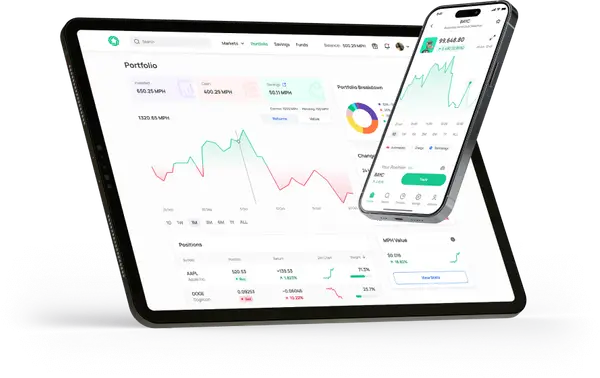
Common Types of Trend Reversal Patterns
1. Head and Shoulders
Identification
Left Shoulder: The price rises to a peak and then declines.
Head: The price rises again to a higher peak and then declines.
Right Shoulder: The price rises again but to a lower peak compared to the head, then declines.
Neckline: A line connecting the lows after the left shoulder and the head, acting as a support level.
Example: Imagine a stock rising to $50 (left shoulder), then to $60 (head), and then to $55 (right shoulder). The lows between these peaks might be $45 and $50.
Analysis: When the price breaks below the neckline at $45, it confirms a bearish reversal. Traders should consider short positions or exiting long positions at this point, anticipating a further decline.
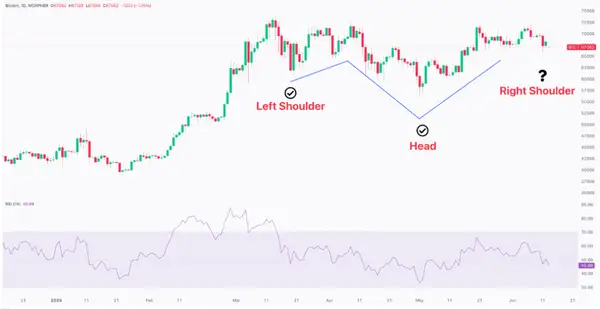
2. Double Top and Double Bottom
Double Top
Identification
Two peaks form at approximately the same level after an uptrend.
The support level between the peaks acts as a critical level.
Example: A stock rises to $70, drops to $65, rises again to $70, and then drops.
Analysis: A break below the $65 support level confirms a bearish reversal. Enter short positions when the price breaks below this level, expecting the trend to reverse downward.
Double Bottom
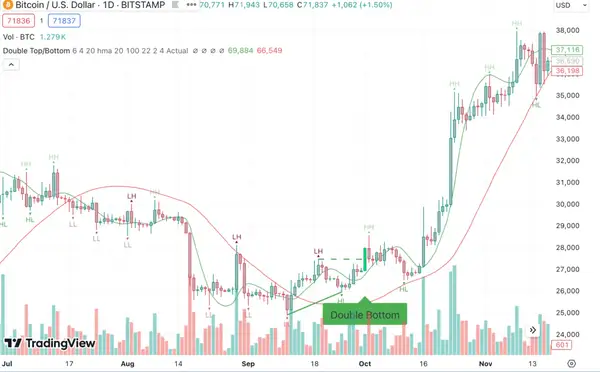
Identification
Two troughs form at approximately the same level after a downtrend.
The resistance level between the troughs acts as a critical level.
Example: A stock falls to $30, rises to $35, falls again to $30, and then rises.
Analysis: A break above the $35 resistance level confirms a bullish reversal. Enter long positions when the price breaks above this level, expecting the trend to reverse upward.
3. Triple Top and Triple Bottom
Triple Top
Identification
Three peaks form at approximately the same level after an uptrend.
The support level connecting the troughs acts as a critical level.
Example: A stock rises to $100, drops to $90, rises again to $100, drops to $90, rises a third time to $100, and then drops.
Analysis: A break below the $90 support level confirms a bearish reversal. Enter short positions when the price breaks below this level, expecting the trend to reverse downward.
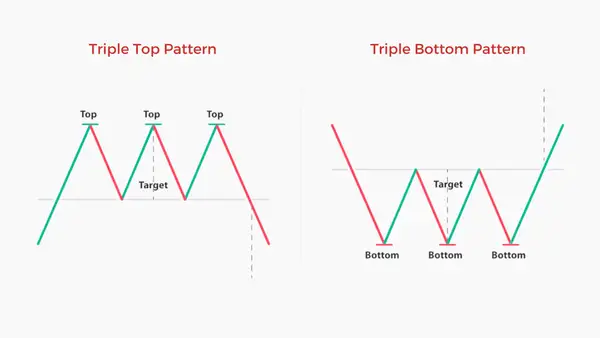
Triple Bottom
Identification
Three troughs form at approximately the same level after a downtrend.
The resistance level connecting the peaks acts as a critical level.
Example: A stock falls to $20, rises to $25, falls again to $20, rises to $25, falls a third time to $20, and then rises.
Analysis: A break above the $25 resistance level confirms a bullish reversal. Enter long positions when the price breaks above this level, expecting the trend to reverse upward.
4. Rising and Falling Wedges
Rising Wedge
Identification
Higher highs and higher lows form converging lines during an uptrend.
The wedge narrows as the trend progresses.
Example: A stock’s price forms a rising wedge by making consecutive higher highs and higher lows, but the highs and lows start converging.
Analysis: A break below the lower trend line of the wedge signals a bearish reversal. Enter short positions when the price breaks below this line, anticipating a downward move.
Falling Wedge
Identification
Lower highs and lower lows form converging lines during a downtrend.
The wedge narrows as the trend progresses.
Example: A stock’s price forms a falling wedge by making consecutive lower highs and lower lows, but the highs and lows start converging.
Analysis: A break above the upper trend line of the wedge signals a bullish reversal. Enter long positions when the price breaks above this line, anticipating an upward move.
By familiarizing yourself with these common trend reversal patterns, you can better anticipate market shifts and make informed trading decisions. Understanding and recognizing these patterns is a valuable skill that can enhance your trading strategy and improve your overall performance.
Strategies for Trading Trend Reversals
To succeed in trend reversal trading, you must adopt robust risk management strategies. As with any trading approach, there are risks involved. By implementing proper risk management techniques, such as setting stop-loss orders and managing position sizes, you can protect your capital and mitigate potential losses.
Setting up a trend reversal trade involves carefully analyzing the market and selecting optimal entry and exit points. By conducting thorough research and using technical analysis tools, you can increase your chances of executing successful trades. Remember to consider various factors, such as support and resistance levels, trendline breaks, and candlestick patterns.
Furthermore, it is essential to pay attention to market sentiment and news events that could potentially impact the trend reversal. Traders often use a combination of fundamental and technical analysis to gain a comprehensive understanding of market conditions before entering a trade. By staying informed about economic indicators, geopolitical developments, and central bank announcements, traders can make more informed decisions.
Additionally, diversification is a key aspect of risk management in trend reversal trading. By spreading your investments across different asset classes or markets, you can reduce the impact of volatility in any single position. Diversification can help balance your portfolio and minimize the overall risk exposure, especially during uncertain market conditions.
Common Mistakes in Trend Reversal Identification
Although trend reversal patterns provide promising trading opportunities, there are common pitfalls that traders must avoid. One common mistake is misinterpreting market noise as genuine reversals. It is essential to differentiate between temporary fluctuations and significant trend shifts to make informed trading decisions.
Another mistake to be cautious of is overreliance on single indicators. While indicators can provide valuable insights, relying solely on one indicator may lead to inaccurate conclusions. It is critical to utilize a combination of indicators and consider multiple factors before confirming a trend reversal.
Furthermore, traders often fall into the trap of emotional decision-making when identifying trend reversals. Emotions such as fear, greed, or overconfidence can cloud judgment and lead to impulsive actions. It is important for traders to maintain a disciplined approach based on a well-defined strategy rather than succumbing to emotional reactions.
Additionally, a lack of proper risk management is another prevalent mistake in trend reversal identification. Failing to set stop-loss orders or disregarding risk-to-reward ratios can expose traders to significant losses. Implementing effective risk management practices is crucial in safeguarding capital and ensuring long-term trading success.
My Personal Advice
Throughout my journey as a trend reversal trader, I have experienced ups and downs. The key to success lies in perseverance and a disciplined approach. It is important to develop your own trading style and stick to it, even during challenging times. Trust your analysis, manage your risks, and always strive for continuous improvement.
FAQ
What are trend reversal patterns?
Trend reversal patterns indicate a shift in market sentiment, where the prevailing trend changes direction. These patterns provide valuable insights for traders to identify potential opportunities.
How can I identify trend reversal patterns?
To identify trend reversal patterns, pay attention to key indicators such as price action, volume, and momentum. Understanding these indicators and their interaction can help you spot potential trend reversals.
What are the common mistakes to avoid in trend reversal identification?
Avoid misinterpreting market noise as genuine reversals and overrelying on single indicators. It is important to differentiate between temporary fluctuations and significant trend shifts and consider multiple factors before confirming a trend reversal.
How can I enhance my trend reversal trading skills?
Continuous learning and practice are essential in enhancing your trading skills. Stay updated on market trends, explore new technical analysis tools, and leverage technology to gain an edge in identifying and capitalizing on trend reversal patterns.
What is your personal advice for trend reversal traders?
My personal advice is to persevere and maintain discipline in your approach. Develop your own trading style, manage your risks effectively, and always strive for continuous improvement through learning and practice.
Can you share a personal story related to trend reversal trading?
Early in my career, I made the mistake of relying solely on a single indicator to identify trend reversals. This led to several failed trades, and I learned the hard way that it is crucial to consider multiple indicators and factors before confirming a trend reversal. This experience taught me the importance of conducting thorough analysis and not rushing into trades without proper confirmation.
In conclusion, uncovering trend reversal patterns is a valuable skill for traders. By understanding their definition, identifying key indicators, employing effective strategies, and avoiding common mistakes, you can enhance your trading skills and increase your chances of success. Remember to continuously learn, practice, and leverage technology to stay ahead of the game. Happy trading!
Ready to put your newfound knowledge of trend reversal patterns into action? Look no further than Morpher, the revolutionary trading platform that's changing the game with blockchain technology. With Morpher, you can trade a vast array of assets, from stocks and cryptocurrencies to unique markets like NFTs and sneakers, all with zero fees and infinite liquidity. Whether you're looking to invest fractionally with as little as $1, short sell without interest fees, or amplify your trades with up to 10x leverage, Morpher offers a safe, flexible, and innovative trading experience. Sign up now to enjoy all of these features and get your free sign-up bonus. Embrace the future of trading and make the most of market opportunities with Morpher.

Disclaimer: All investments involve risk, and the past performance of a security, industry, sector, market, financial product, trading strategy, or individual’s trading does not guarantee future results or returns. Investors are fully responsible for any investment decisions they make. Such decisions should be based solely on an evaluation of their financial circumstances, investment objectives, risk tolerance, and liquidity needs. This post does not constitute investment advice.

Painless trading for everyone
Hundreds of markets all in one place - Apple, Bitcoin, Gold, Watches, NFTs, Sneakers and so much more.

Painless trading for everyone
Hundreds of markets all in one place - Apple, Bitcoin, Gold, Watches, NFTs, Sneakers and so much more.




